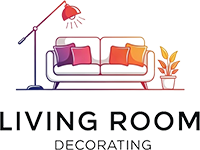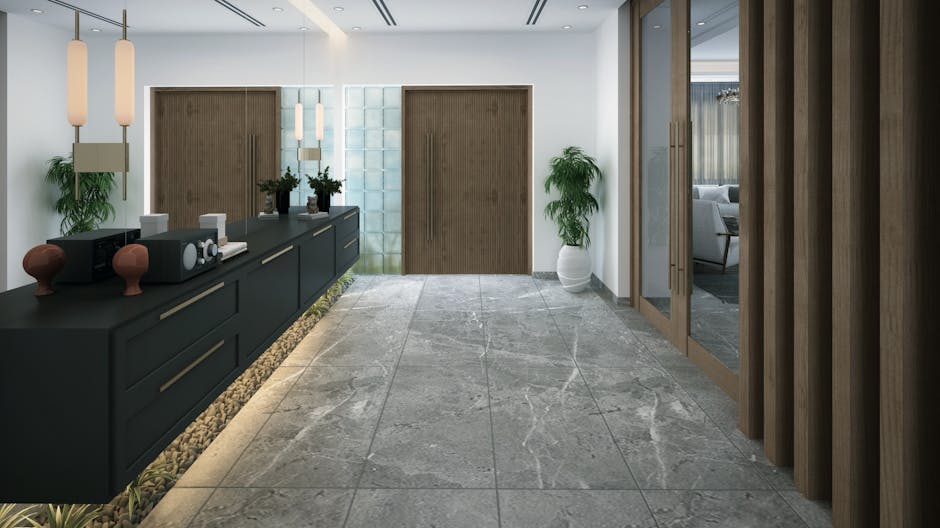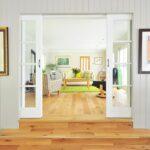So, your front door dumps you straight into the living room, huh? Many homes face this layout challenge. It might not be your dream entryway. Many find it less-than-ideal. But hey, don’t despair! You absolutely CAN style this area to be both functional and gorgeous. We are talking about creating a great first impression as one of our prime goal. The important thing is, you can make the most of it with some smart design choices. This is about transforming an entry woe into a design win.
Understanding the Layout Challenge
First things first. Lets look at what exactly makes this layout a bit of a puzzler. The primary issue stems from the lack of a defined foyer. Without that transitional space, the living room immediately becomes the dumping ground. For shoes, coats, mail… you name it. This situation create clutter quickly. More importantly, it lacks the psychological buffer. One needs a space to decompress from the outside world.
- Lack of Definition: No clear boundary between the public (outside) and private (living space) zones.
- Clutter Magnet: Shoes, coats, bags, and other outdoor gear tend to accumulate near the entry.
- Noise Intrusion: Sounds from outside can easily penetrate the living space.
- Visual Chaos: The immediate view into the living room can feel overwhelming without careful planning.
- Privacy Concerns: Depending on the window placement, a lack of privacy can be a significant concern too.
Consider how natural light affects your layout also. Direct sunlight can fade furniture. Inadequate lighting, however, can make the space feel gloomy.
Creating a Visual Barrier: Defining Zones
The key to success is to create a visual and physical separation between the entryway and the living area. This tricks the eye and provides a sense of order. You can use this separation to divide a larger space.
Room Dividers: A Designer’s Best Friend
Room dividers are a great solution. They come in various styles and materials.
- Bookshelves: A stylish and functional choice. Offers storage and displays your personality. Consider an open-back bookshelf to allow light to filter through.
- Screens: Available in various materials, from bamboo to fabric-covered frames. Offers privacy and a decorative element.
- Curtains: A softer option, providing a visual separation without completely blocking the view.
- Plants: A natural and refreshing way to define the space. Tall potted plants or a plant wall can create a lush barrier.
- Consoles: A lower-profile divider that allows light to pass through. Great for displaying decorative items and storing keys or mail.
The use of color is imperative. Think about how these colors play off of each other.
Area Rugs: Grounding the Entry Zone
An area rug is a simple way to designate the entryway. Choose a durable, low-pile rug that can withstand heavy foot traffic. Use rugs to make the room feel larger. Use a smaller rug, if the goal is to define that entryway.
- Material: Consider a natural fiber rug like jute or sisal for durability. Synthetic materials are also good choices, especially in high-traffic areas.
- Size: The rug should be large enough to accommodate all the furniture in the entryway zone. But small enough to leave walking space.
- Pattern: A patterned rug can help hide dirt and stains, making it a practical choice.
Furniture Arrangement: Strategic Placement is Vital
Carefully plan the arrangement of your living room furniture. This can define the entry zone. Consider these arrangements as follows.
- Sofa Placement: Position the sofa so that its back faces the front door. This creates a natural barrier and defines the seating area.
- Console Table: Place a console table against the back of the sofa. This serves as a buffer and offers a surface for lamps, flowers, or other decorative items.
- Armchairs: Arrange armchairs to create a conversation area, further defining the living space.
- Entryway Bench: Add a bench near the door for seating and shoe storage. A storage bench is even better, offering a place to stash clutter.
Maximizing Storage: Taming the Clutter Monster
Effective storage is critical. Especially when your front door opens directly into the living room. It's about finding stylish solutions. That hide everyday clutter and keep the space looking tidy.
Entryway Furniture: Functionality Meets Style
Invest in furniture. Specifically designed for entryways.
- Coat Racks: A stylish coat rack can keep jackets and outerwear organized. Choose one that complements your decor.
- Shoe Storage Cabinets: A must-have for any entryway. Provides a place to store shoes neatly and prevent clutter.
- Key Holders: Keep keys organized and easily accessible with a decorative key holder.
- Mail Organizers: Prevent mail from piling up on the coffee table with a wall-mounted mail organizer.
Creative Storage Solutions: Think Outside the Box
Get creative with storage solutions.
- Baskets: Use decorative baskets to store blankets, throws, or toys.
- Ottomans: An ottoman with hidden storage is a great way to add seating and stash clutter.
- Wall-Mounted Shelves: Install shelves to display decorative items and store books or other belongings.
- Hidden Storage: Look for furniture with hidden storage compartments. Such as coffee tables with lift-up tops or sofas with built-in drawers.
Lighting: Setting the Mood and Enhancing Visibility
Lighting is vital for both function and aesthetics. A well-lit entryway feels more inviting. A living room benefits from layered lighting. This creates ambiance and increases usability.
Entryway Lighting: A Bright and Welcoming Glow
Ensure your entryway is well-lit.
- Overhead Lighting: A ceiling fixture provides general illumination. A stylish pendant light or chandelier can add a touch of elegance.
- Table Lamps: Place a table lamp on a console table or side table for task lighting and ambiance.
- Wall Sconces: Install wall sconces to add a decorative touch and provide additional lighting.
Living Room Lighting: Creating Layers of Light
Layer your lighting to create a warm and inviting atmosphere.
- Ambient Lighting: Provides overall illumination in the room.
- Task Lighting: Provides focused light for reading, writing, or other tasks.
- Accent Lighting: Highlights specific features or objects in the room.
Decorating the Entryway: Making a Statement
Your entryway is the first impression. Make it count with thoughtful decor. Consider these elements to enhance the sense of welcome.
Artwork: Adding Personality and Visual Interest
Hang artwork that reflects your style and sets the tone for the rest of the living room. A large statement piece can create a focal point. Smaller pieces can add visual interest to a gallery wall.
- Placement: Hang artwork at eye level for optimal viewing.
- Style: Choose artwork that complements the overall aesthetic of the living room.
- Color: Use color to tie the artwork to the rest of the decor.
Mirrors: Reflecting Light and Creating Space
Mirrors are a great addition to any entryway.
- Placement: Position a mirror opposite the front door to reflect light and create a sense of spaciousness.
- Size: Choose a mirror that is proportionate to the size of the wall.
- Style: Select a mirror frame that complements your decor.
Accessories: Finishing Touches
Accessorize the entryway with personal touches that reflect your style.
- Plants: Add greenery to brighten the space and create a welcoming atmosphere.
- Flowers: A vase of fresh flowers can add a pop of color and fragrance.
- Decorative Bowls: Use decorative bowls to hold keys, coins, or other small items.
- Throw Pillows: Add throw pillows to a bench or chair for comfort and style.
Color Palette: Creating Harmony and Flow
The color palette plays a huge role in creating the overall ambiance of the living room. Choose colors that complement each other and create a sense of harmony.
Entryway Colors: Light and Bright
Opt for lighter colors in the entryway to make the space feel brighter and more welcoming. Neutral colors like white, beige, and gray are good choices. As are soft pastels.
Living Room Colors: Creating Depth and Interest
In the living room, you can use a wider range of colors to create depth and interest. Consider using a mix of neutral colors. As well as accent colors.
- Accent Wall: Paint one wall in a bold color to create a focal point.
- Color Blocking: Use different colors to define different zones in the room.
- Color Accents: Add pops of color with throw pillows, blankets, and accessories.
Flooring: Durable and Stylish Options
The flooring in the entryway should be durable and easy to clean. It should also complement the flooring in the living room.
Entryway Flooring: Practical and Stylish
Consider these flooring options for the entryway:
- Tile: A durable and water-resistant option that is easy to clean.
- Hardwood: A classic and elegant choice. Make sure to seal it properly to protect it from moisture.
- Laminate: A more affordable alternative to hardwood. Also easy to maintain.
- Vinyl: A durable and water-resistant option that comes in a variety of styles.
Living Room Flooring: Comfort and Aesthetics
In the living room, you can choose flooring options that are more focused on comfort and aesthetics.
- Carpet: A soft and comfortable option that is perfect for creating a cozy atmosphere.
- Hardwood: A classic and elegant choice that adds warmth and character to the room.
- Area Rugs: Use area rugs to define different zones in the room and add texture and pattern.
Maintaining the Space: Keeping it Tidy and Inviting
Regular maintenance is key to keeping the entryway and living room looking tidy and inviting. It also can help add to the overall feel of the decor.
Daily Tasks: Quick and Easy Habits
Incorporate these daily tasks into your routine.
- Put away shoes and coats: Make it a habit to put away shoes and coats as soon as you enter the house.
- Check the mail: Sort through the mail and discard junk mail immediately.
- Wipe down surfaces: Wipe down surfaces like console tables and benches to prevent dust and dirt from accumulating.
Weekly Tasks: Deeper Cleaning
Set aside time each week for a more thorough cleaning.
- Vacuum or sweep: Vacuum or sweep the floors to remove dirt and debris.
- Dust furniture: Dust furniture and accessories to keep them looking their best.
- Clean mirrors and windows: Clean mirrors and windows to remove streaks and smudges.
Seasonal Tasks: Refreshing the Space
Perform these tasks seasonally to keep the space looking fresh and inviting.
- Declutter: Go through your belongings and get rid of anything you no longer need or use.
- Deep clean: Perform a deep clean of the entire space, including washing windows, cleaning carpets, and polishing furniture.
- Rearrange furniture: Rearrange furniture to create a fresh new look.
Common Mistakes to Avoid
Even with all the right knowledge, it's easy to make mistakes when designing a living room with a direct-entry layout. Be aware of these common pitfalls.
Overcrowding: Less is More
Avoid overcrowding the space with too much furniture or decor. This can make the room feel cramped and cluttered.
Ignoring Traffic Flow: Create a Clear Path
Ensure there is a clear path from the front door to the rest of the living room. Avoid placing furniture in a way that blocks the flow of traffic.
Neglecting Storage: Address Clutter
Neglecting storage solutions can lead to clutter and disorganization. Invest in storage furniture and accessories to keep the space tidy.
Ignoring Lighting: Brighten the Space
Inadequate lighting can make the room feel dark and uninviting. Ensure there is adequate lighting in both the entryway and the living room.
Lack of Cohesion: Create Harmony
Ensure that the decor in the entryway complements the decor in the living room. Avoid mixing styles or colors that clash.
By avoiding these mistakes, you can create a living room that is both stylish and functional. Even with the challenge of a direct-entry layout.
Adapting to Different Styles
The ideas presented here can be adapted to various design styles, ensuring your direct-entry living room reflects your taste.
Minimalist: Streamlined and Functional
- Color Palette: Neutral tones.
- Furniture: Essential pieces only.
- Decor: Minimal accessories.
Bohemian: Eclectic and Artistic
- Color Palette: Earthy tones with pops of vibrant colors.
- Furniture: Mix-and-match pieces.
- Decor: Global influences.
Modern: Sleek and Contemporary
- Color Palette: Black, white, and gray with pops of color.
- Furniture: Clean lines and geometric shapes.
- Decor: Minimal accessories.
Traditional: Classic and Elegant
- Color Palette: Rich, warm colors.
- Furniture: Ornate details and classic shapes.
- Decor: Formal and refined.
Thinking About Accessibility: Making it Easier for Everyone
When designing a living room with a direct-entry layout, accessibility should be a priority. Think about how easily people can move in and out of the space, especially those with mobility issues.
- Clear Pathways: Ensure there are wide, clear pathways from the front door to the rest of the living room.
- Ramps and Thresholds: If there are any steps or thresholds at the entrance, consider adding ramps or leveling the floor.
- Easy-to-Reach Storage: Place storage furniture and accessories within easy reach.
- Adequate Lighting: Ensure there is adequate lighting in the entryway to improve visibility.
Final Thoughts: Transforming the Challenge into an Opportunity
While having your front door open directly into the living room can seem like a design obstacle. It's an opportunity to create a unique and inviting space. Use room dividers, area rugs, and strategic furniture arrangement to define the entryway. And create a sense of separation. Maximize storage to keep clutter at bay and add personal touches. These will give the room style. Remember, thoughtful planning and creative solutions. This transform any layout challenge into a design masterpiece. By considering all the suggestions above, you can create a living room that is both stylish and functional. It is also reflective of your unique personality.
Last modified: June 14, 2025



